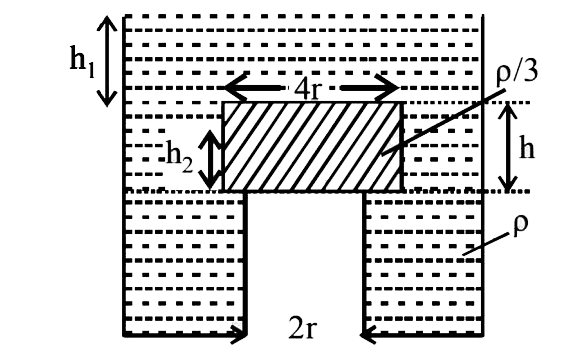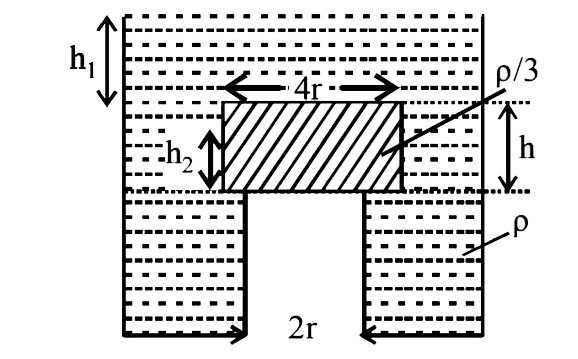A cylindrical tank has a hole of 1cm2 in its bottom. If the water is allowed to flow into the tank from a tube above it at the rate of 70cm3/sec, then the maximum height up to which water can rise in the tank is
2.5cm
5cm
10cm
0.25cm
The correct Answer is:A
To solve the problem, we need to find the maximum height (h) of water that can rise in a cylindrical tank with a hole at the bottom. The water is flowing into the tank at a rate of 70 cm³/sec, and the hole has an area of 1 cm².
1. Identify the Rates:
- The rate of water flowing into the tank (Vin) is given as 70 cm³/sec.
- The area of the hole (A) is given as 1 cm².
2. Determine the Efflux Speed:
- The efflux speed (v) of water exiting through the hole can be calculated using Torricelli’s theorem, which states:
v=√2gh
where g is the acceleration due to gravity (approximately 9.81m/s2) and h is the height of the water column.
3. Calculate the Rate of Water Exiting:
- The rate of water exiting the tank (Vout) can be expressed as:
Vout=A⋅v=A⋅√2gh
- Substituting the area of the hole:
Vout=1cm2⋅√2gh
4. Set the Rates Equal for Maximum Height:
- At maximum height, the rate of water flowing in equals the rate of water flowing out:
Vin=Vout
- Therefore:
70cm3/s=1⋅√2gh
5. Solve for h:
- Rearranging the equation gives:
√2gh=70
- Squaring both sides:
2gh=4900
- Now, substituting g=981cm/s2 (since we are using cm for height):
2⋅981⋅h=4900
- Simplifying:
1962h=4900
- Thus:
h=49001962≈2.5cm
Final Answer:
The maximum height up to which water can rise in the tank is 2.5 cm.
- The rate of water flowing into the tank (Vin) is given as 70 cm³/sec.
- The area of the hole (A) is given as 1 cm².
- The efflux speed (v) of water exiting through the hole can be calculated using Torricelli’s theorem, which states:
v=√2gh
where g is the acceleration due to gravity (approximately 9.81m/s2) and h is the height of the water column.
- The rate of water exiting the tank (Vout) can be expressed as:
Vout=A⋅v=A⋅√2gh
- Substituting the area of the hole:
Vout=1cm2⋅√2gh
- At maximum height, the rate of water flowing in equals the rate of water flowing out:
Vin=Vout
- Therefore:
70cm3/s=1⋅√2gh
- Rearranging the equation gives:
√2gh=70
- Squaring both sides:
2gh=4900
- Now, substituting g=981cm/s2 (since we are using cm for height):
2⋅981⋅h=4900
- Simplifying:
1962h=4900
- Thus:
h=49001962≈2.5cm
The maximum height up to which water can rise in the tank is 2.5 cm.
Topper's Solved these Questions
Similar Questions
A cylindrical tank whose cross-section area is 2000cm2 has a hole in its bottom 1cm2 in area.
(i) If the water is allowed to flow into the tank from a tube above it at the rate of 140 cm3/s, how high will the water in the tank rise ?
(ii) If the flow of water into the tank is stopped after the above height has been reached, how long will it take for tank to empty itself through the hole?
View SolutionA large cylindrical tank has a hole of area A at its bottom. Water is oured in the tank by a tube of equal cross sectional area A ejecting water at the speed v.
View Solution
Knowledge Check
A tank filled with fresh water has a hole in its bottom and water is flowing out of it. If the size of the hole is increased, then
Athe volume of water flowing out per second will decreaseBthe velocity of outflow of water remains unchangedCthe volume of water volume out per second remains zeroDBoth (b) and (c)
A cylindrical tank has a small hole at bottom. At t=0, a tap starts to supply water into the tank at a constant rate βm3/s.
(a) Find the maximum level of water Hmax in the tank ?
(b) At what time level of water becomes h(h<Hmax) Given a , area of hole, A : area of tank.
View SolutionA tank has a hole at its bottom. The time needed to empty the tank from level h1 to h2 will be proportional to
View SolutionA tank of height H and base area A is half filled with water and there is a small orifice at the bottom and there is a heavy solid cylinder having base area A3 and height of the cylinder is same as that of the tak. The water is flowing out of the orifice. Here cylinder is put into the tank to increase the speed of water flowing out.
After long time, when the height of water inside the tank again becomes equal to H2, the solid cylinder is taken out. then the velocity of liquid flowing out of the orifice (just after removing the cylinder) will be
View SolutionSuppose that water is emptied from a spherical tank of radius 10 cm. If the depth of the water in the tank is 4 cm and is decreasing at the rate of 2 cm/sec, then the radius of the top surface of water is decreasing at the rate of
View SolutionA cylindrical tank has a hole of diameter 2r in its bottom. The hole is covered wooden cylindrical block of diameter 4r, height h and density ρ/3.

Situation I: Initially, the tank is filled with water of density ρ to a height such that the height of water above the top of the block is h1 (measured from the top of the block).
Situation II: The water is removed from the tank to a height h2 (measured from the bottom of the block), as shown in the figure. The height h2 is smaller than h (height of the block) and thus the block is exposed to the atmosphere.
Find the minimum value of height h1 (in situation 1), for which the block just starts to move up?
View SolutionA cylindrical tank has a hole of diameter 2r in its bottom. The hole is covered wooden cylindrical block of diameter 4r, height h and density ρ/3.

Situation I: Initially, the tank is filled with water of density ρ to a height such that the height of water above the top of the block is h1 (measured from the top of the block).
Situation II: The water is removed from the tank to a height h2 (measured from the bottom of the block), as shown in the figure. The height h2 is smaller than h (height of the block) and thus the block is exposed to the atmosphere.
Find the minimum value of height h1 (in situation 1), for which the block just starts to move up?
View SolutionA cylindrical tank has a hole of diameter 2r in its bottom. The hole is covered wooden cylindrical block of diameter 4r, height h and density ρ/3.

Situation I: Initially, the tank is filled with water of density ρ to a height such that the height of water above the top of the block is h1 (measured from the top of the block).
Situation II: The water is removed from the tank to a height h2 (measured from the bottom of the block), as shown in the figure. The height h2 is smaller than h (height of the block) and thus the block is exposed to the atmosphere.
In situation 2, if h2 is further decreased, then
View Solution
